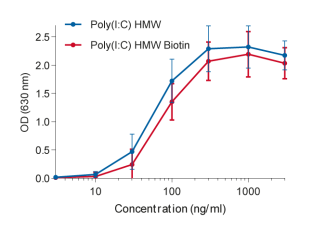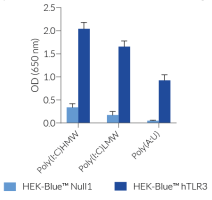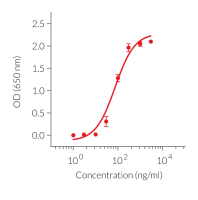Poly(I:C) (HMW) Biotin
-
Biotin-labeled synthetic analog of dsRNA
-
Cat.code:
tlrl-picb
- Documents
ABOUT
Biotin-labeled synthetic analog of dsRNA
Poly(I:C) HMW Biotin is biotin-labeled Toll-like receptor 3 (TLR3) agonist. It was chemically produced by covalent coupling of biotin with high molecular weight polyinosinic-polycytidylic acid (poly(I:C) HMW). Poly(I:C) HMW, with an average size of 1.5-8 kb, comprises long strands of inosine poly(I) homopolymer annealed to strands of cytidine poly(C) homopolymer. The labeled ligand retains the biological activity of poly(I:C).
Poly(I:C) is a synthetic analog of double-stranded RNA (dsRNA), a molecular pattern associated with viral infection. Both natural and synthetic dsRNAs are known to induce type I interferon (IFN) production [1]. Depending on its location in the cell, poly(I:C) can activate distinct pattern recognition receptor (PRR) pathways: endosomal poly(I:C) activates TLR3 [2], whereas cytosolic poly(I:C) activates retinoic acid-inducible protein I (RIG-I) [3], melanoma differentiation-associate gene 5 (MDA-5) [4], and protein kinase RNA-activated (PKR) [5]. Activation of these PRRs results in the induction of multiple signaling pathways, including NF-κB and IFN regulatory factors (IRFs).
Poly(I :C) HMW Biotin can be used for various applications, including histochemical staining, cytometry, fluorescence microscopy, and ligand binding assays [6, 7].
InvivoGen's Poly(I :C) HMW Biotin is of the highest quality and guaranteed free of bacterial contamination. Each lot is thoroughly tested to ensure the absence of lot-to-lot variation.
Key features of Poly(I:C) Biotin:
- Potent inducer of TLR3 activity
- Designed to assess Poly(I:C) binding
- Each lot is functionally tested
References:
1. Kawasaki T. & Kawai T., 2014. Toll-like receptor signaling pathways. Front Immunol. 5:461.
2. Alexopoulou L. et al., 2001. Recognition of double-stranded RNA and activation of NF-κB by Toll-like receptor 3. Nature, 413:732-8.
3. Kawai T. & Akira S., 2008. Toll-like receptor and RIG-I-like receptor signaling. Ann N Y Acad Sci. 1143:1-20.
4. McCartney S. et al., 2009. Distinct and complementary functions of MDA5 and TLR3 in poly(I:C)-mediated activation of mouse NK cells. J Exp Med. 206(13):2967-76.
5. Lemaire P.A. et al., 2008. Mechanism of PKR Activation by dsRNA. J Mol Biol. 381(2):351-60.
6. Hasan M. et al, 2011. Antimicrobial peptides inhibit polyinosinic-polycytidylic acid-induced immune responses. J Immunol. 187(11):5653-9.
7. Sugimoto N. et al., 2014. Helicase proteins DHX29 and RIG-I cosense cytosolic nucleic acids in the human airway system. PNAS. 111(21):7747-52.
All products are for internal research use only, and not for human or veterinary use.
SPECIFICATIONS
Specifications
TLR3
30 ng - 1 μg/ml
100 µg/ml in water
The absence of bacterial contamination (e.g. lipoproteins and endotoxins) is confirmed using HEK-Blue-Lucia™ TLR2 and HEK-Blue-Lucia™ TLR4 cells.
Fluorescent TLR3 labeling
Flow cytometry
Fluorescent microscopy
Confocal microscopy
TLR3 activation
Ligand binding assay
Each lot is functionally tested and validated.
CONTENTS
Contents
-
Product:Poly(I:C) (HMW) Biotin
-
Cat code:tlrl-picb
-
Quantity:10 µg
1.5 ml endotoxin-free water
Shipping & Storage
- Shipping method: Room temperature
- -20°C
- Avoid repeated freeze-thaw cycles
Storage:
Caution:
DOCUMENTS
Documents
Technical Data Sheet
Safety Data Sheet
Validation Data Sheet
Certificate of analysis
Need a CoA ?






